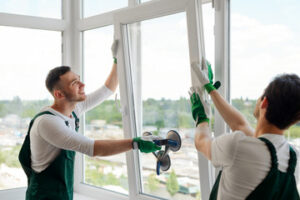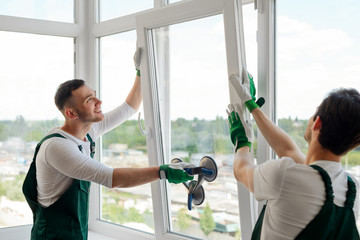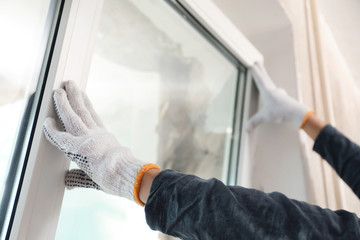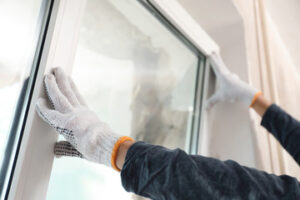Unlike new construction windows, Window Replacement fits into existing window openings. Installing them correctly helps ensure they look good and function smoothly, meet energy efficiency ratings, and don’t leak air.
Before sliding the window into place, check it for squareness with a bubble level. Add shims around the frame to prop it up if it’s out of plumb.
The frame is the backbone of a window, and the choice will impact both visual appeal and energy efficiency throughout a home. There are four main frames to consider: wood, aluminum, fiberglass and vinyl. Each has its own set of pros and cons to take into account during the replacement process.
When it comes to choosing a new frame, homeowners often overlook the importance of selecting a style that complements their home and suits their aesthetic preferences. A good frame is not only sturdy and long-lasting, but also offers a distinctive appearance that enhances curb appeal.
Full frame replacement involves removing the existing exterior trim, siding and window and replacing the whole unit. This option may be the best choice if your current window is in poor condition with a damaged or failing seal and operating hardware.
While the cost of full frame replacement can be more expensive than insert replacement, it typically requires less time and is easier to install. In addition, it can offer greater flexibility in terms of window placement and size.
For an added level of protection and durability, many homeowners choose to clad their wood windows with either aluminum or vinyl. This adds an additional layer of defense from the elements, which can reduce maintenance needs and protect the interior wood from moisture damage, insect infestation and rot.
The cladding is typically colored to match the frame and can be used to conceal any gaps in between the frame and finished wall surface. This can give your replacement windows a sleek and modern appearance that works well with more contemporary homes.
Sash
The window sash is the point of friction when you open and close your windows. It’s also the point of entry for water and air, so it needs to be functioning properly in order to keep your home healthy. If you notice that your windows are not opening and closing or are leaking, it’s likely time for a replacement window sash.
Window sashes can be made out of wood, aluminum, or vinyl. All of these have their own unique properties, so consult with a window specialist before choosing your sash material. In addition, you’ll want to consider the style and appearance of your home and choose a sash that will complement your home’s aesthetic.
Once you have decided on your sash material, you’ll need to determine if you need hardware. Depending on your situation, you may need a lock and keeper or tilt latches to help with the operation of your windows. Additionally, if your sash is older or in need of repair, you may need meeting rails and a parting bead to keep the window in place.
In most cases, homeowners only need to replace their window sash when it has become worn out from weather changes and age. This can cause issues like rotting and water leakage. You can check for sash damage by poking the wood with a screw driver. If the screw driver sinks in, this is a sign that the sash needs to be replaced.
If you’re considering window sash replacement, it’s important to understand that this is just a temporary fix and will not solve any long term problems. It’s important to work with a professional window contractor to install new, energy-efficient windows that will give you the performance you deserve in the future. To learn more about your options, contact us today to get matched with top-rated pros in your area. We can provide you with a free quote and help you find the best solution for your needs. Just enter your zip code to get started.
Glass
Window glass allows light to enter your home while providing privacy, noise reduction and energy efficiency. It also offers a variety of decorative options including frosted, textured and stained glass. Today’s homes have larger windows and more glass doors than ever before, so educating yourself on the different types of window glass can help you determine what options would work best for your home.
The glass of a window can be single or double pane, and can include a space that is filled with argon or krypton to improve energy efficiency. The space between the panes can be tinted or coloured to reduce glare and heat transfer. Window glass can also be reinforced or laminated to increase strength and durability, and many have special coatings that enhance insulating properties or prevent condensation.
Laminated glass fuses a layer of polyvinyl butyral to the windowpane, making it extremely strong and preventing splintering or distortion. It is often used in awning and casement windows that open and close using a crank handle, or in skylights. Strengthened glass is another option that increases safety by breaking into small shards instead of sharp, jagged pieces. This type of glass is also called tempered glass, and is sometimes used in storm-resistant windows.
Patterned glass is available to provide both a decorative look and privacy, with designs that include geometric shapes, natural forms and abstract patterns. It is popular in doors with glass panels and French windows. Safety glass is a must-have in areas where windows and doors can break accidentally and harm a person. It is a shatter-resistant type of glass with a built-in, rounded edge design that helps prevent injuries caused by flying glass shards.
Aside from the frame and sash, other parts of a window include weatherstripping, hardware, hinges, stays and more. Weatherstripping is a material that seals the gap between the sash and the frame to reduce air leakage and improve energy efficiency. Hinges hold the sash in place and provide support against the weight of the glass. Stays, which are usually found on sash corners, are levers that assist in opening and closing the window.
Hardware
Several hardware items may be necessary for the replacement of your windows. For example, you may need window operators for your double- or single hung windows to open and close them. These operators, also known as lift rails or crank handles, come in a variety of styles and finishes to match your home décor. Operators are a crucial part of your window because they enable you to let in fresh air. If you find that yours are broken or worn out, they can be easily replaced with new hardware from Amesbury Truth.
You may also need a window operator for a casement or awning window, which open by “cranking” outward. These window styles utilize a cam lock and crank handle to operate, so it’s important that this hardware is in good condition and functioning properly. Again, Amesbury Truth produces top-of-the-line window operators that are available in a wide variety of colors and finishes to complement your existing style.
If your windows are damaged beyond repair, it’s likely time to replace them. Cracked or warped frames and sashes are not only unsightly, but they allow moisture, air, pests and heat to enter your home.
Depending on the severity of your damage, replacing your windows may require that you remove and discard the old frame casing. If the damage is minimal, you may be able to retain the existing casing and replace just the window sash.
In most cases, a new window requires installation into an existing wall system. However, in some situations you may be able to have a window installed into a pocket of an existing frame, a process known as a pocket replacement. These special windows are a great way to add value to your home and increase its energy efficiency while maintaining the historical integrity of an older property.





